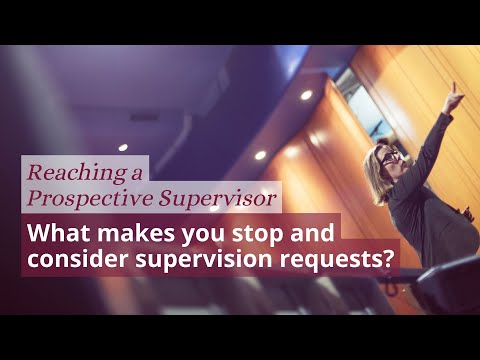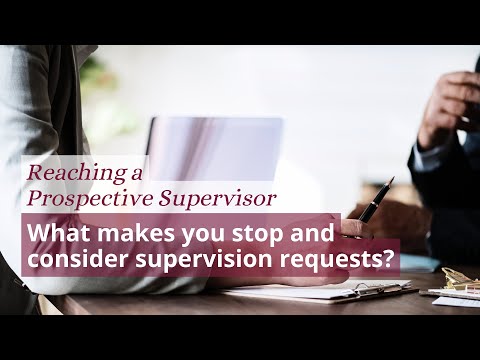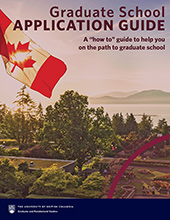Sanja Miskovic
Research Classification
Research Interests
Relevant Thesis-Based Degree Programs
Affiliations to Research Centres, Institutes & Clusters
Research Methodology
Recruitment
Complete these steps before you reach out to a faculty member!
- Familiarize yourself with program requirements. You want to learn as much as possible from the information available to you before you reach out to a faculty member. Be sure to visit the graduate degree program listing and program-specific websites.
- Check whether the program requires you to seek commitment from a supervisor prior to submitting an application. For some programs this is an essential step while others match successful applicants with faculty members within the first year of study. This is either indicated in the program profile under "Admission Information & Requirements" - "Prepare Application" - "Supervision" or on the program website.
- Identify specific faculty members who are conducting research in your specific area of interest.
- Establish that your research interests align with the faculty member’s research interests.
- Read up on the faculty members in the program and the research being conducted in the department.
- Familiarize yourself with their work, read their recent publications and past theses/dissertations that they supervised. Be certain that their research is indeed what you are hoping to study.
- Compose an error-free and grammatically correct email addressed to your specifically targeted faculty member, and remember to use their correct titles.
- Do not send non-specific, mass emails to everyone in the department hoping for a match.
- Address the faculty members by name. Your contact should be genuine rather than generic.
- Include a brief outline of your academic background, why you are interested in working with the faculty member, and what experience you could bring to the department. The supervision enquiry form guides you with targeted questions. Ensure to craft compelling answers to these questions.
- Highlight your achievements and why you are a top student. Faculty members receive dozens of requests from prospective students and you may have less than 30 seconds to pique someone’s interest.
- Demonstrate that you are familiar with their research:
- Convey the specific ways you are a good fit for the program.
- Convey the specific ways the program/lab/faculty member is a good fit for the research you are interested in/already conducting.
- Be enthusiastic, but don’t overdo it.
G+PS regularly provides virtual sessions that focus on admission requirements and procedures and tips how to improve your application.
ADVICE AND INSIGHTS FROM UBC FACULTY ON REACHING OUT TO SUPERVISORS
These videos contain some general advice from faculty across UBC on finding and reaching out to a potential thesis supervisor.
Supervision Enquiry
Graduate Student Supervision
Master's Student Supervision
Theses completed in 2010 or later are listed below. Please note that there is a 6-12 month delay to add the latest theses.
The application of insoluble mineral flocculation-flotation on an ultrafine, high insoluble mineral (insol) content stream utilizing flotation column technology was evaluated as an alternate method to dissolution in separating insoluble minerals from residual salts in fine potash tailings. This study was a novel application of insoluble flocculation-flotation due to the high insol composition, the ultrafine particle size distribution, and the use of column flotation technology, which has yet to be implemented in a slimes flotation duty on an industrial scale. The feed insol content was 5-25 times higher than typical slimes flotation applications with a P80 of 30 µm compared to 3350 µm.A twelve-inch diameter by five-meter-tall pilot column with an external cavitation sparging system was installed in the plant to trial slimes flotation of an ultrafine, high clay stream with an ethoxylated amine collector. The column operating parameters were optimized, and a statistical approach was taken to evaluate the flotation response and determine the flotation column sizing parameters. The results conclude that collector-less insol flotation utilizing column technology from a high clay, ultrafine stream was successful, with a modeled optimum of 88.2% insol rejection and 86.7% KCl recovery; however, the patented method of flocculation-flotation is invalid in this application, due to the observed destruction of flocs in the flotation pulp arising from the power intensity of the column external sparging system and the significant column residence time. Direct comparison of the pilot separation efficiencies with a more power-intensive flotation machine revealed that the selectivity performance of the column was equipment limited. Complete liberation of the insoluble minerals, a fundamental characteristic of the ultrafine stream, resulted in near-ideal separation efficiencies from sylvite at high insol rejection rates when sufficient power intensity was provided; however, individual insol mineral flotation was found to be unselective. Column flotation of the ultrafine high clay stream was characterized by a low carrying capacity of 0.9 t/h/m2 and a long residence time of 17 minutes. Sparger energy intensity, collector addition, pulp density, feed composition, and brine temperature were found to be statistically significant predictors of insol rejection (R2 = 80.47%).
View record
In mineral processing industries, stirred media mills are known for achieving smaller particlesize and better energy intensity in comminution. The mill consists of a rotating shaft drivingdiscs, pins, or skews known as a stirrer powered by a motor coupled outside the mill chamber.The rotating shaft transmits the kinetic energy to the grinding media.Every mineral has its distinctive physical properties, making it hard to create general standards to cover all materials that the stirred media mills might process. Therefore, to addressspecific applications, different stirred media mills were built with varying stirrer designs. Themill’s performance improvements are complicated, which are related to grinding and energy efficiency, because of the lack of flow profiles inside the system, which vary based on the stirrershapes. The lack of flow profiles is due to the high-density slurry media flow, which complicates the enhancement of stirred mills performance. However, it is necessary to increase thecomminution efficiency in stirred media mills to reduce its power consumption.To overcome these flow monitoring issues, the grinding mechanisms, and fluid-particles flowmixtures for a better understanding, numerical models are commonly used in smaller particlesizes. In this study, slurry and grinding media suspension behaviour are captured using a multi-phase computational model. Media particle collisions with each other and walls are solvednumerically using Discrete Element Method (DEM), while single-phase slurry flow is simulatedusing Computational Fluid Dynamics (CFD) and the combined effects are established throughcoupling these numerical methods. Media particles’ grinding efficiency is estimated using stressintensity generated by particle collision. This study focuses on developing and validating a high-performance multi-scale numerical model to simulate agitated stirred mills filled with granularmedia and slurry. Also, the effects of operating and design parameters on the hydrodynamicsof the system and particle breakage is considered for efficiency optimization. The proposedhigh-fidelity CFD-DEM numerical approach with dynamic meshing helps to understand thefluid-particle flow behaviour inside the mill and optimize the design parameters for performanceimprovements of VXPmills, which leads to the evolution of a new design with enhanced grindingefficiency with less torque.
View record
The biomedical and pharmaceutical industries have explored the use of pillar arrays for microparticle separation of cancer cells, blood cells, and droplets extensively. Over the recent years, other sectors such as the powder industry are beginning to apply devices with structured pillar arrays for particle classification due to their small footprint, passive nature, and ability to achieve multiple cut points within a single device. This thesis investigates if the structured pillar arrays can have utility for the size-based classification of macro-and mesoscale spherical glass beads and crushed ore particles. Multiple pillar array designs are evaluated in this work on a small bench-scale apparatus that allows manipulation of the array tilt angle, which is a parameter used to control the separation cut point. The experiments with target samples are conducted individually, first considering monosized glass beads and then crushed ore samples over the particle size range between 2000 and 8000 microns. The scope of this research work is constrained by the size of the structured pillar array used in this study, which is designed for coarse particle classification (>500 microns and
View record
As supplies of valuable minerals become scarcer and demand increases, the mining industry must develop more efficient and effective methods to recover these minerals from ore. Various gravity separation methods are extensively used in the industry for concentration of gold, platinum group metals (PGMs), mineral sands, chromite, tin, tantalum, tungsten, iron ore, cobalt and many other metals and minerals with sufficient differences in density. The Falcon enhanced gravity separator is one example of a semi-batch enhanced gravity separation device that uses centrifugal force to enable liberated precious metal recovery within grinding circuits and from placer deposits. During run cycle, concentrator accepts feed continuously, heavy particles are retained in the riffled section of the unit’s bowl, and concentrate is produced during periodic rinse cycles by water jets. Limited research has attempted to understand particle behaviour in the riffled section of the Falcon enhanced gravity separator, and little is known about the effect of design and operating parameters on the unit’s concentration efficiency. This thesis focuses on studying particle behaviour in the riffled section of the Falcon gravity separator’s bowl to recover the highest fraction of heavy particles. An open thin channel setup was built to emulate a cross-section of Falcon gravity separator’s riffled section. Testing was conducted on the effects of riffle designs, inclination angles, and flow rates on particle behaviour. This study shows the need and value of improving the gravity separators' bowl geometry, which would significantly benefit heavy retention capabilities of this equipment.Two experimental setups using a centrifugal pump and a peristaltic pump were developed to test 9 riffle designs over 4 flow rates and 3 inclination angles resulting in 99 distinct experimental cases. Semi-elliptical designs coupled with lower inclination angles and flow rates lead to higher heavy particle retention in riffles. This considerably improved particle recovery rates of the system possibly due to its ability to expel light particles from the riffles while pushing the heavy particles downward.Observations of particle behaviour in this study can serve as a foundation for study on Falcon enhanced gravity separator and any gravity separation devices using engineered riffles.
View record
Fine ore grinding is a relatively new technology in the industry, generally operated in stirred media mills filled with grinding media and a mixture of water and ore particles known as slurry. Stirred mills have been increasingly used in ultra-fine grinding circuits. However, there is limited understanding of the influence of many process and design parameters on the mill’s performance. To gain more knowledge about those parameters, this study focuses on the development and validation of DEM numerical models, which are then used to evaluate the design of FLSmidth's VXPmill and identify its critical process parameters. Laboratory experiments and material parameters calibration tests were conducted on a pilot-scale 10 liters mill to validate the numerical model and provide more insight into the mill operation, mixing pattern, and power consumption. This thesis focuses on the analysis and optimization of the key operating and design parameters and investigates their effects on the kinetic energy, collision efficiency, abrasive wear rate, and momentum transfer rate to the media inside the vertical stirred mill. A Lagrangian numerical model based on the discrete element method (DEM) is developed and used to gain a fundamental understanding of the dynamic behavior of grinding media in the mill. Specifically, the distribution of stress intensity levels inside the mill for different grinding media properties, rotational velocities, and mill designs was investigated in depth. Various configurations of a selection of parameters are studied, both design and operational. Operation parameters such as stirrer speed, media load, size, and density are examined individually and concurrently. The general trend of the results shows an increase in kinetic and collision energies as the input variables are increased, while also an increase in power consumption and liner wear is observed. A design of experiment study considered gradual improvements to the original design of the VXP10 mill rotor. The study examined variations in the disc geometry, spacing, and hole size and number. The design parameter study considered introducing vertical impellers to improve the momentum transfer to the media particles. The results from this design of experiments allowed the development of various alternative rotor designs to the VXP10.
View record
In order to achieve economic operation and enable efficient separation of valuable components, most mineral processing facilities require comminution technologies. These machines liberate valuable minerals from the associated gangue by reducing the size of individual particles, or, in some operations, by removing loosely adhered particles from the hard mineral matrix. Due to the stochastic nature of particle-particle and particle-wall collisions, as well as the intrinsic inefficiencies associated with the low fraction of energy spent on particle breakage, these technologies require enormous amounts of energy to function and, therefore, research into the development and implementation of more efficient technologies is continuously ongoing.This study assesses the performance of high pressure slurry ablation, a new size reduction, particle liberation, and slurry conditioning technology, against current industry standards. Various materials were tested with the equipment, and product samples were collected and analyzed for size distribution and size-based assaying. Where applicable, separation technologies such as gravity separation and froth flotation were used to provide further insights into the amenability of HPSA products to beneficiation. The results were then compared to the expected outcomes of typical grinding and scrubbing-attrition technologies.The results concluded that the technology can achieve size reduction for all considered materials, can selectively liberate soft and loosely attached materials into a fraction of the original mass, and can provided elevated gravity separation recoveries in precious metals applications. However, due to the mechanical components of the pilot-scale unit used in this study limiting the percentage of solids that the unit could handle, the observed unit efficiencies are found to be lower than those of conventional size reduction units. By upgrading the pumps associated with the testing rig these limitations could be eliminated, thus, identifying areas for future work.
View record
The jet mill operates on the principle of collisions between particles to grind ultrafine powder material without the introduction of heat or any other external force and is capable of particle size reduction from about 100 microns down to 250 nm. The optimization process depends on parameters such as feed rate, grinding air pressure, physical characteristics of the solids (density, hardness, abrasiveness, or tenacity), physical characteristics of the mill shell liner, as well as feed and product particle size distribution (PSD).This research studied the optimization of the jet mill grinding process of ultrafine metallurgical powders in a small-scale 4” jet mill. The research was aimed to understand the effects of feed rate, compartment pressure, and feed particle size distribution on overall mill efficiency and iron entrainment using a stainless-steel shell. In addition, the effect of a polymer-based shell coating on milling efficiency, shell abrasion rate, and iron contamination reduction was assessed. The main variables affecting grinding such as feed rate, grinding air pressure, and feed size were investigated. Optimal operating conditions for running the lab scale jet mill are at the pressure range of 70 to 80 psi, with a feed rate of 3 to 5 kg/hr. At high grinding air pressures, the jet mill produces a small particle size, but high pressure requires more gaseous fluid which makes the process less efficient by consuming more energy.It is concluded that density and hardness seem to have a significant effect on the product fineness. Hard materials such as TaC, WC, and WTiTaC resulted in a finer product size than soft materials like TiC. High grinding air pressure has a greater effect on harder materials than on softer materials in achieving the fine product size. It is understood that jet milling can be more effective than ball milling if the optimum parameters are followed, as recommended in the study; such as feed rate, pressure, feed size, and the liner used in producing the metallurgical powders TiC, TaC, WC, or a combination of any of these.
View record
Publications
- An instance mask representation for bubble size distribution in two-phase bubble flotation column based on deep learning model (2025)
Flow Measurement and Instrumentation, 104 - Analysis of particle dispersion and cavity formation during bulk particle water entry using fully coupled CFD-DEM-VOF approach (2024)
Particuology, 90, 558-580 - CFD-DEM validation and simulation of gas–liquid–solid three phase high-speed jet flow (2024)
Chemical Engineering Research and Design, 201, 561-578 - Process intensification of metal solvent extraction studies using a miniaturized solvent extraction plant (2024)
Chemical Engineering and Processing - Process Intensification, 199 - An Analysis of CFD-DEM with Coarse Graining for Turbulent Particle-Laden Jet Flows (2023)
Fluids, 8 (7) - Investigation of particle effects on bubble coalescence in slurry with a chimera MP-PIC and VOF coupled method (2023)
Chemical Engineering Science, 265 - GIPPE-RPT: Geant4 interface for particle physics experiments applied to Radioactive Particle Tracking (2022)
Applied Radiation and Isotopes, 180 - Transfer learning for radioactive particle tracking (2022)
Chemical Engineering Science, 248 - A chimera approach for MP-PIC simulations of dense particulate flows using large parcel size relative to the computational cell size (2021)
Chemical Engineering Journal Advances, 5 - A new method for calibration of radioactive particle tracking systems using computational fluid dynamics and Monte Carlo simulation data (2021)
CFB 2021 - Proceedings of the 13th International Conference on Fluidized Bed Technology, 351-356 - A study of RANS turbulence models in fully turbulent jets: A perspective for CFD-DEM simulations (2021)
Fluids, 6 (8) - Review of peridynamic modelling of material failure and damage due to impact (2021)
International Journal of Impact Engineering, 147 - Analysis of coupled CFD-DEM simulations in dense particle-laden turbulent jet flow (2020)
American Society of Mechanical Engineers, Fluids Engineering Division (Publication) FEDSM, 2 - VortexFitting: A post-processing fluid mechanics tool for vortex identification (2020)
SoftwareX, 12 - CFD simulation of single-phase flow in flotation cells: Effect of impeller blade shape, clearance, and Reynolds number (2019)
International Journal of Mining Science and Technology, 29 (5), 657-669 - The effect of particle size on coal flotation kinetics: A review (2018)
Physicochemical Problems of Mineral Processing, 54 (4), 1172-1190 - A high-order moment-conserving method of classes (HMMC) based population balance model for mechanical flotation cells (2017)
Minerals Engineering, 108, 36-52 - Investigation of gas dispersion characteristics in stirred tank and flotation cell using a corrected CFD-PBM quadrature-based moment method approach (2016)
Minerals Engineering, 95, 161-184 - Numerical and experimental investigation of single phase flow characteristics in stirred tanks using Rushton turbine and flotation impeller (2015)
Minerals Engineering, 83, 156-167 - Numerical simulation of fluid flow in deterministic lateral displacement devices (2013)
American Society of Mechanical Engineers, Fluids Engineering Division (Publication) FEDSM, 2 - Numerical study of single phase liquid mixing in stirred tanks fitted with Rushton Turbine and standard flotation impeller (2013)
ASME International Mechanical Engineering Congress and Exposition, Proceedings (IMECE), 7 A - Comparison of two bubble sizing methods for performance evaluation of mechanical flotation cells (2012)
Separation Technologies for Minerals, Coal, and Earth Resources, 563-574
If this is your researcher profile you can log in to the Faculty & Staff portal to update your details and provide recruitment preferences.



